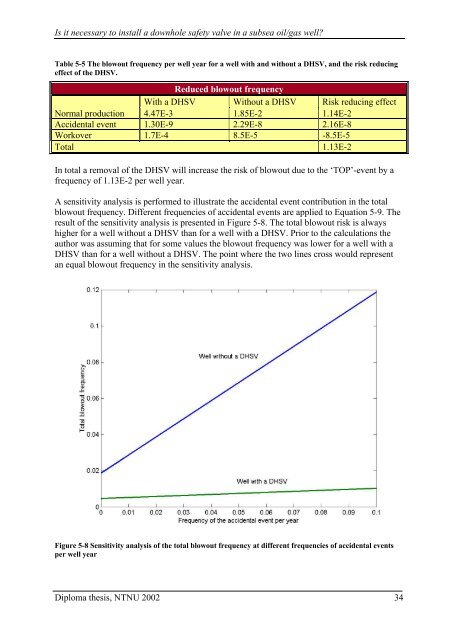Is it necessary to install a downhole safety valve in a subsea ... - NTNU
Is it necessary to install a downhole safety valve in a subsea ... - NTNU
Is it necessary to install a downhole safety valve in a subsea ... - NTNU
Create successful ePaper yourself
Turn your PDF publications into a flip-book with our unique Google optimized e-Paper software.
<strong>Is</strong> <strong>it</strong> <strong>necessary</strong> <strong>to</strong> <strong><strong>in</strong>stall</strong> a <strong>downhole</strong> <strong>safety</strong> <strong>valve</strong> <strong>in</strong> a <strong>subsea</strong> oil/gas well?<br />
Table 5-5 The blowout frequency per well year for a well w<strong>it</strong>h and w<strong>it</strong>hout a DHSV, and the risk reduc<strong>in</strong>g<br />
effect of the DHSV.<br />
Reduced blowout frequency<br />
W<strong>it</strong>h a DHSV W<strong>it</strong>hout a DHSV Risk reduc<strong>in</strong>g effect<br />
Normal production 4.47E-3 1.85E-2 1.14E-2<br />
Accidental event 1.30E-9 2.29E-8 2.16E-8<br />
Workover 1.7E-4 8.5E-5 -8.5E-5<br />
Total 1.13E-2<br />
In <strong>to</strong>tal a removal of the DHSV will <strong>in</strong>crease the risk of blowout due <strong>to</strong> the ‘TOP’-event by a<br />
frequency of 1.13E-2 per well year.<br />
A sens<strong>it</strong>iv<strong>it</strong>y analysis is performed <strong>to</strong> illustrate the accidental event contribution <strong>in</strong> the <strong>to</strong>tal<br />
blowout frequency. Different frequencies of accidental events are applied <strong>to</strong> Equation 5-9. The<br />
result of the sens<strong>it</strong>iv<strong>it</strong>y analysis is presented <strong>in</strong> Figure 5-8. The <strong>to</strong>tal blowout risk is always<br />
higher for a well w<strong>it</strong>hout a DHSV than for a well w<strong>it</strong>h a DHSV. Prior <strong>to</strong> the calculations the<br />
author was assum<strong>in</strong>g that for some values the blowout frequency was lower for a well w<strong>it</strong>h a<br />
DHSV than for a well w<strong>it</strong>hout a DHSV. The po<strong>in</strong>t where the two l<strong>in</strong>es cross would represent<br />
an equal blowout frequency <strong>in</strong> the sens<strong>it</strong>iv<strong>it</strong>y analysis.<br />
Figure 5-8 Sens<strong>it</strong>iv<strong>it</strong>y analysis of the <strong>to</strong>tal blowout frequency at different frequencies of accidental events<br />
per well year<br />
Diploma thesis, <strong>NTNU</strong> 2002<br />
34


